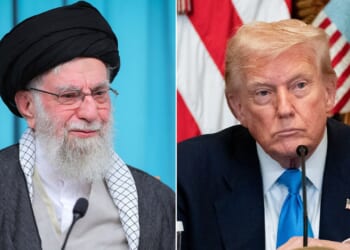The Russian military is focusing its efforts in the resource-rich region of the Donbas, where the war between Ukraine and Russian-backed separatists has raged since 2014.
In the ongoing war in Ukraine, the Russian military continues to make slow progress forward, seizing hundreds of square miles of Ukrainian territory—mostly in the contested eastern Donbas region—every month.
Moscow’s rate of advance, however, is extremely slow, and comes at a very heavy cost in Russian lives and equipment. Moreover, the Kremlin’s plans to establish a buffer zone between the two countries, separating them after hostilities conclude, appears to be failing.
Understanding Russia’s Rate of Advance
“Russian Ground Forces (RGF) highly likely seized approximately 500-550 sq km [around 200 square miles] of Ukrainian territory in July 2025,” the British Ministry of Defence assessed in its latest intelligence estimate on the Russo-Ukrainian conflict—observing that this rate of advance was roughly the same as it had been in June and in previous months.
The Russian military is moving more slowly than its leadership would have liked—but it is advancing. Moscow is trading men for territory, but it has a distinct advantage in the war of attrition. Kyiv does not have the same manpower capacity, and Ukrainian units are often forced to retreat under heavy Russian pressure in order to conserve fighting strength. Whether Russia’s force-generation capabilities will ultimately give the Russian military the upper hand in the war is yet to be determined.
The Russian military is focusing its efforts in the resource-rich region of the Donbas, where the war between Ukraine and Russian-backed separatists has raged since 2014.
“The RGF continued to make tactical advances in Donetsk oblast, primarily to the north-east and south-west of Pokrovsk. RGF is continuing attempts to envelop the town and apply pressure to the remaining logistical routes to the town,” the British Ministry of Defence assessed.
Pokrovsk is a key logistics hub in the Donbas. If the Russian military succeeds in capturing the fortified town, the Ukrainian forces’ ability to conduct offensive and defensive operations in southeastern Ukraine will suffer significantly. As the British Ministry of Defence noted, the Russian forces are now in control of almost all the Donetsk Oblast south of Pokrovsk.
Putin’s Plan for a Ukrainian Buffer Zone Is Flailing
Russian leader Vladimir Putin recently announced a goal to establish a buffer zone between Ukraine and Russian territory—mainly in response to the bold Ukrainian foray into Russia’s Kursk Oblast in August 2024. Establishing that buffer zone, however, has proven far more difficult than the Kremlin estimated.
“In the last two weeks RGF have not made any observable gains in the Ukrainian oblast of Sumy, which borders the Russian oblasts of Kursk and Belgorod. Continued losses and Ukrainian counterattacks have likely frustrated the Russian intent to establish a buffer zone in the Sumy region,” the British Ministry of Defence estimated.
According to reports, the Russian 51st Airborne Regiment, 106th (VDV) Division, deployed in the Sumy Oblast, is refusing to follow orders as a result of “casualty-heavy infantry assaults.” VDV units are some of the most elite formations in the entire Russian Armed Forces and are typically used for the hardest missions. The three-year conflict in Ukraine has taken a toll on the VDV forces, severely diminishing their numbers and readiness.
“It is highly likely that Ukrainian forces continue to conduct limited operations in the border region of Russia’s Kursk oblast, over a year after launching the initial incursion,” the British Ministry of Defence concluded in its intelligence analysis.
President Donald Trump is set to meet with Putin in Alaska on Friday. The general hope is that the meeting will result in a viable—and acceptable by Ukraine—solution to end the three-year conflict, but many analysts are skeptical that the meeting will result in durable steps toward peace.
About the Author: Stavros Atlamazoglou
Stavros Atlamazoglou is a seasoned defense journalist specializing in special operations and a Hellenic Army veteran (national service with the 575th Marine Battalion and Army HQ). He holds a BA from the Johns Hopkins University and an MA from the Johns Hopkins’ School of Advanced International Studies (SAIS). His work has been featured in Business Insider, Sandboxx, and SOFREP.
Image: Shutterstock / Octavio Hoyos.















